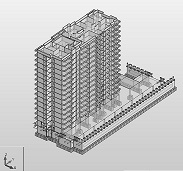Assessment of displacements in reinforced concrete buildings for the operation of 5G antennas in Chile
DOI:
https://doi.org/10.13140/RG.2.2.13378.81609Keywords:
5G communication networks, lateral displacements, accidental regulatory charges, numerical simulationAbstract
The imminent emergence of 5G networks in the Chilean telecommunications market has made it essential to anticipate the possible imbalances that these could reach when any of the earthquakes that repeatedly strike the country occurs. To do this, a methodology based on conventional linear elastic analysis, both spectral modal and time-history, has been formulated to estimate the induced displacements for two different levels of strong ground movements, based on seismic records obtained in the subduction zone. The results obtained have served to obtain fairly adjusted analytical expressions, formulated from a single system variable, the height of the level, so that they can be used to quickly estimate the lateral displacements of the 5G antennas that will be networked, by personnel who has no training in structural dynamics, but who will be in charge of making the adjustments in the 5G network nodes
Downloads
References
[2] J. García, «https://andro4all.com» Available: https://andro4all.com/2018/01/que-es-como-funciona-5g, 2018
[3] C. López and J. Music, Análisis del período desplazamiento de edificios de hormigón armado considerando distintos grados de rigidez en sus elementos resistentes, Antofagasta, Chile, 2016
[4] A. Sil and T. Longmailai, «Drift Reliability Assessment of a Four Storey Frame Residential» J Inst Eng. India Ser A, vol. 98, nº 3, pp. 245-256, 2017
[5] J. Shan, X. Chen, H. Yuan and W. Shi, «Interstory drift estimation of nonlinear structure using acceleration measurement with test validation» J Eng Mech, vol. 141, nº 10, 2015
[6] E. Miranda, «Estimation of maximum interstory drift in displacement-based design», Slovenia, 1997
[7] R. Aguiar, «Nueva Metodología y parámetro B6» de Evaluación rápida de la deriva máxima de piso para calcular la vulnerabilidad sísmica de estructuras, Barcelona, España, Monografías de Ingeniería Sísmica, pp. 105-110, 2006
[8] H. Scaletti, «Estimación Rápida de Desplazamientos Laterales Producidos por Sismo» Lima, Perú, 2007
[9] J. C. Vielma, A. Barbat and S. Oller, «Seismic performance of buildings with waffled-slab floors» Structures & Buildings., vol. 162, pp. 169-182, 2009
[10] J. Vielma and M. Mulder, «Improved procedure for determining the ductility of buildings under seismic loads» Revista Internacional de Métodos Numéricos para cálculo y diseño en Ingeniería, vol. 34, pp. 1-27, 2018
[11] V. Petrov, D. Solomitckii, A. Samuylov, M. Lema, M. Gapeyenko, D. Moltchanov, S. Andreev, V. Naumov, K. Samouylov, M. Dohler and Y. Koucheryavy, «Dynamic Multi-Connectivity Performance in Ultra-Dense Urban mmWave Deployments» IEEE Journal on Selected Areas in Communications, vol. 35, nº 9, pp. 2038-2055, 2017
[12] R. Zhang, X. Lu, J. Zhao, L. Cai and J. Wang, «Measurement and modeling of angular spreads of three-dimensional urban street radio channels» IEEE Transactions on Vehicular Technology, vol. 66, nº 5, pp. 3555-3570, 2017
[13] H. Mei, J. Bigham, P. Jiang and E. Bodanese, «Distributed dynamic frequency allocation in fractional frequency reused relay based cellular networks» IEEE Transactions on Communications, vol. 61, nº 4, pp. 1327-1336, 2013
[14] S. Rangan, T. Rappaport and E. Erkip, «Millimeter-Wave Cellular Wireless Networks: Potentials and Challenges», Brooklyn, United Estates, 2014
[15] INN, NCh1537.Of1986 «Diseño estructural de edificios - Cargas permanentes y sobrecargas de uso», Santiago, Chile, 2009
[16] INN, Nch433.Of1996 «Diseño sísmico de edificios», Santiago, Chile, 2009
[17] INN, Nch432.Of2010 «Cálculo de la acción del viento sobre las construcciones», Santiago, Chile, 2010
[18] S. Tikoo, «Exploring Autodesk Revit 2019 for Structure», Schererville Indiana: CADCIM Technologies, 2018
[19] MINVU-Ministerio de Vivienda y Urbanismo, D.S. N°60. V. y U. «Diseño y cálculo de hormigón armado», Santiago de Chile: D.S. N°60. V. y U. - Diseño y cálculo de hormigón armado, 2011
[20] MINVU-Ministerio de Vivienda y Urbanismo, D.S. N°61. V y U. «Diseño sísmico de edificios», Santiago de Chile: MINVU-Ministerio de Vivienda y Urbanismo, 2011
[21] A. Seco, F. Tirapu, F. Ramírez, G. B. y J. Cabrejas, «Assessing building displacement with GPS. Building and Environment» Building and Environment, vol. 42, pp. 393-399, 2005
[22] J. Tapia y F. Bravo, «Análisis Dinámico No-Lineal de Comportamiento del Edificio "Mercado Puerto" Reforzado», Valparaíso, Chile, 2019
[23] ACHISINA, «Diseño Sísmico Basado en Desempeño un procedimiento alternativo para el análisis y diseño sísmico de edificios, Santiago de Chile: Asociación Chilena de Sismología e Ingeniería Antisísmica», Chile, 2017
[24] A. Kappos y S. Stefanidou, «A deformation-based seismic method for 3D R/C irregular buildings using dynamic analysis» Bulletin of Earthquake Engineering, vol. 8, nº 2010, pp. 875-895, 2010

Published
How to Cite
Issue
Section
The opinions expressed by the authors do not necessarily reflect the position of the editor of the publication or UCLA. The total or partial reproduction of the texts published here is authorized, provided that the complete source and electronic address of this journal is cited. Authors have the right to use their articles for any purpose as long as it is done nonprofit. The authors can post on the internet or any other media the final approved version of their work.






.png)




